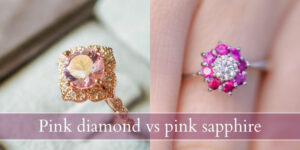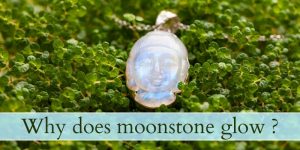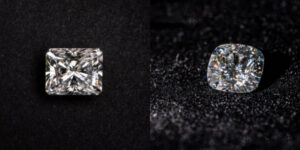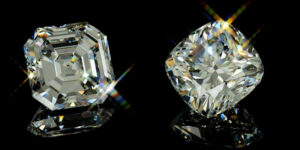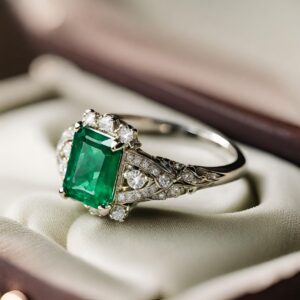If you’re in love with emeralds it’s most likely because of that deep green with hints of blue, like a deep forest on a misty day. And when it comes to green gems, there is no other like emerald, at least in terms of color. So it might surprise you to find out that malachite actually gives emerald a run for its money in terms of that cool green shade. There are quite a few differences between malachite and emerald, and we’ll explore those key differences today, as well as their defining similar feature.
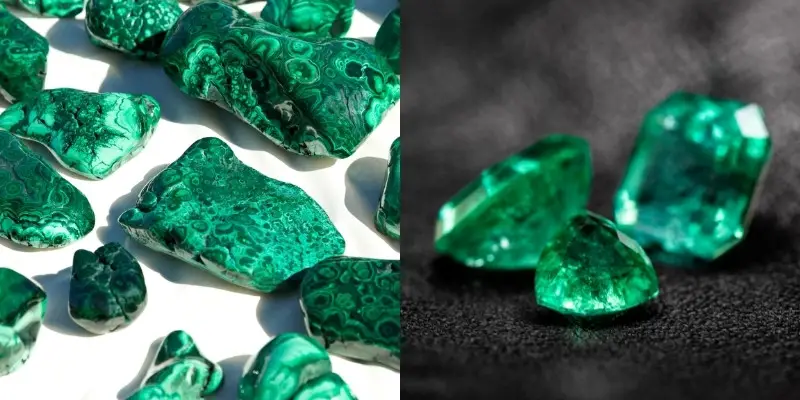
Malachite vs emerald
Both malachite and emerald shade a deep green color, but emerald is much more expensive than malachite, and is far more durable both in jewelry and as an ornament. Malachite is harder to find at jewelers and retailers because it’s not as popular as emerald, but you can find it in small-scale shops or niche shops.
Overall it seems that both malachite and emerald are ancient gemstone, well known and mined since thousands of years ago. But emerald has build a strong reputation as a luxury gemstone, a precious gem reserved only for the very wealthy and of high status while malachite has remained more of a carving gem.
What is malachite ?
Malachite is a form of copper carbonate hydroxide, and it owes its green color to a copper oxidation. This gem is just as ancient as emerald, in that it was known and mined thousands of years ago, with the oldest mine being the Great Orme Mine in Wales some 3,800 years ago.
This gemstone was used both to extract copper and also as an ornamental gem. It usually forms as a banded gemstone, does not form as a single crystal, like you would find quartz for example. Instead malachite grows in nooks and crannies in deep rocks where water comes and deposits trace amounts of copper. The result is a heavily-banded gem, and in some cases it grows in a pattern very similar to that of felt. Millions of short, thin crystals packed very closely together.
Read also: What Gemstones Are Brown ?
What is emerald ?
Emerald is a type of beryl and it owes its green color to trace amounts of chromium, and occasionally vanadium. This is one of the most ancient gemstones, along with diamonds, amethysts, and rubies. Emeralds have been used for ornamental purposes for thousands of years and have gained a strong reputation as luxury gems.
Emerald grows in rough crystals with no specific shape, but it does tend to have a vague 6-sided crystal shape at times.
1. Malachite is a much softer gem than emerald
Malachite is not a hard gemstone by any means. Due to its structure it tends to scratch and chip very easily. Malachite scores a 3.5 on the Mohs hardness scale, while emerald scores an 8 on the same scale. For reference a diamond scores a 10, the highest possible score and is the toughest gemstone.
So if you’re wondering which gem would be safer to wear in everyday jewelry, emerald is much safer as it won’t scratch as easily as malachite. That being said, emerald does scratch too, so it might be a good idea to wear both emerald and malachite as earrings or pendants.
Emerald tends to have a whole lot of inclusions, which make it a bit brittle, especially if it’s not set in a very protective setting it or has some very sharp corners that are exposed.
2. Emerald is much more expensive than malachite
Emeralds are very, very expensive, and this is due to their rarity (only 4 countries it can be mined from), their prestige, and their rarity as a gemstone in the earth’s crust.
So you will find emerald selling for an average of $7,000 for a vivid colored gem, with a small amount of inclusions (VVS1 and VVS2). There are emeralds that sell for double the price per carat, such as those that are not treated for clarity, and there are emeralds that sell for far less, such as lab-grown emeralds or highly included natural emeralds.
Malachites are far more affordable, as it can be found in abundance in many places, and is often found in very large chunks (think several metric tons !). So because of this you can easily find raw malachite selling for as little as $1 per gram.
But malachite will often be found in already-polished and carved pieces such as vases, decorations, plates, cameos, earrings and so on. For those pieces it’s the complexity of the work and the skill of the lapidary that set the price. Beautifully worked malachite can be worth several thousand USD in some cases. When it comes to jewelry though, it’s much, much more affordable.
3. Malachite needs a protective coating to be handled
Malachite tends to be brittle and as such it may need a protective resin coating to enhance its stability and also to give it a smooth surface. Due to the way malachite grows you can find very large specimens with very small nooks where the surface won’t be smooth, no matter how well carved it is. So, it will often be coated to keep it safe and smooth.
Emeralds don’t need a coating to be handled, they are good to use as they come out of the mine. They do need faceting but that’s about it.
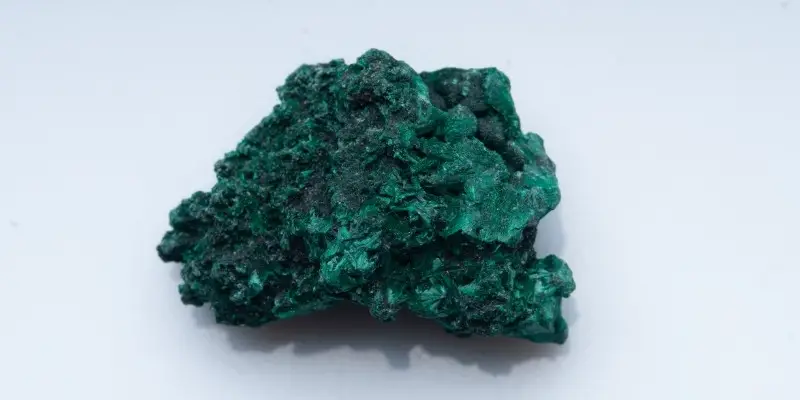
4. Most emeralds on the market are filled or oiled
Emeralds are instead often filled or oiled to mask tiny cracks and imperfections that reach all the way to the surface. This is a treatment for clarity, not stability, nor is it a protective coating. This process is widespread and you will have a very difficult time finding an emerald that has not been treated for clarity. They do exist, but are either heavily included, or quite clear but much more expensive than the average emerald.
Emeralds are never treated for color with heat, but their clarity fillers may have a green tint to them sometimes. This practice is outlawed but might still find some floating around.
Malachites however tend to be opaque stones with lots of banding, so they have no real inclusion and clarity problem. They are not treated for color either. What you see is what you get.
5. Malachite is harder to find than emerald
Emerald is a very popular gemstone, so it’s very easy to find at a jeweler, retailer, or in ready-made jewelry. It’s expensive yes, and can only be mined in 4 places in the world. But it’s a gemstone with very high prestige and many people want it. It’s also the birthstone for May so there’s extra demand for it.
Malachite is easier to find in mines but much less popular than emerald. Because of this jewelers and retailers don’t carry as much malachite as they do emerald, and some don’t carry malachite at all. After all, their main interest is to turn a profit so they will carry what is in the highest demand.
This does not mean you can’t find malachite at all. You can still find it in raw form, pre-carved and faceted, and sometimes even set in jewelry. But you may have to look in places that are not specialized in precious gemstones. So you have a better chance on Amazon, Etsy, or gem fairs where there are plenty of alternative or non-precious stones.
Both malachite and emerald offer a similar green
Malachite and emerald so share one characteristic though, and that is the beautiful shade of deep, dark green with a hit of blue. You can’t really find it in other gems, maybe in green jade but that tends to be slightly different than malachite and emerald.
So if you’re after green jewelry with a very specific color, both emerald and malachite will offer you roughly the same look in terms of color. of course a malachite cannot be transparent and sparkle like an emerald, but it can be used for some jewelry pieces.
Is malachite toxic ?
Malachite is only toxic while it is being processed, such as washed with mild acid, mined, or polished. This is because malachite has very high amounts of copper in it (about 70%) which is never safe for human ingestion.
When malachite is mined or polished, very fine malachite dust can get in the lungs. Workers have to wear protective equipment to keep themselves safe. Another method is to cut and polish malachite under running water, so the dust does not enter the air.
Similarly, if malachite is ever washed in a mild acid the copper in it will reach and emit toxic fumes.
Doe this mean you cannot wear malachite ? No, you can safely wear malachite because it’s not emitting noxious fumes by simply existing in jewelry or as a decorations. For fumes it needs a mild acid.
As for malachite dust, as long as your malachite doesn’t break or shatter, it will not emit any dust. This risk is usually offset by most malachite’s protective resin coating. If you’re unsure of your malachite you should reach out to your jeweler or retailer for answers.

I’m the main author for jewelrymaterialguide.com. I started this site after we did tons of research before our wedding and noticed that there is information about rings, jewelry, and so on that is really hard to find on the internet.

